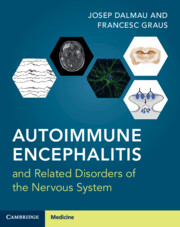Book contents
- Autoimmune Encephalitis and Related Disorders of the Nervous System
- Autoimmune Encephalitis and Related Disorders of the Nervous System
- Copyright page
- Dedication
- Contents
- Clinical Vignettes
- Videos
- Preface
- Abbreviations
- Section 1 Overview
- Chapter 1 Importance, Definitions, History, Classification, and Frequency of the Autoimmune Encephalitides
- Chapter 2 General Approach to Diagnosis
- Chapter 3 Pathogenesis and Disease Mechanisms in Neuronal Antibody-Mediated Encephalitis
- Section 2 Antibodies and Antigens
- Section 3 Specific Syndromes and Diseases
- Section 4 Autoimmunity in Neurological and Psychiatric Diseases
- Index
- References
Chapter 3 - Pathogenesis and Disease Mechanisms in Neuronal Antibody-Mediated Encephalitis
from Section 1 - Overview
Published online by Cambridge University Press: 27 January 2022
- Autoimmune Encephalitis and Related Disorders of the Nervous System
- Autoimmune Encephalitis and Related Disorders of the Nervous System
- Copyright page
- Dedication
- Contents
- Clinical Vignettes
- Videos
- Preface
- Abbreviations
- Section 1 Overview
- Chapter 1 Importance, Definitions, History, Classification, and Frequency of the Autoimmune Encephalitides
- Chapter 2 General Approach to Diagnosis
- Chapter 3 Pathogenesis and Disease Mechanisms in Neuronal Antibody-Mediated Encephalitis
- Section 2 Antibodies and Antigens
- Section 3 Specific Syndromes and Diseases
- Section 4 Autoimmunity in Neurological and Psychiatric Diseases
- Index
- References
Summary
Some types of autoimmune encephalitis associate with distinct HLA haplotypes that likely predispose to the disease (e.g., anti-LGI1 encephalitis or anti-IgLON5 disease). In other instances the autoimmune mechanisms are triggered by tumours that express the neuronal antigen (e.g., small-cell lung cancer and anti-GABAbR encephalitis), or tumours that cause an immune dysregulation (thymoma and anti-GABAaR or anti-AMPAR encephalitis), or viral encephalitis that lead to neuronal destruction and release of antigens (e.g., herpes simplex encephalitis triggering autoimmune encephalitis with NMDAR or GABAaR antibodies). In most autoimmune encephalitis the pathogenic antibodies are IgG1 and cause symptoms by internalization of the target antigen (anti-NMDAR encephalitis) or antibody-mediated complement activation and cellular injury (aquaporin 4 antibodies in neuromyelitis optica spectrum disorders). Direct functional blocking of the antigen has been demonstrated for glycine receptor antibodies and probably GABAbR antibodies. Some autoimmune encephalitis (e.g., anti-LGI1 or CASPR2 encephalitis, anti-IgLON5 disease) associate with predominant IgG4 antibodies that disrupt normal protein–protein interactions. Confirmation of antibody pathogenicity requires that in passive transfer experiments of patients’ antibodies to animals, the antibodies bind to the target neural antigen, alter the structure or function of the antigen, and result in clinical symptoms.
Keywords
- Type
- Chapter
- Information
- Publisher: Cambridge University PressPrint publication year: 2022
References
- 1
- Cited by



